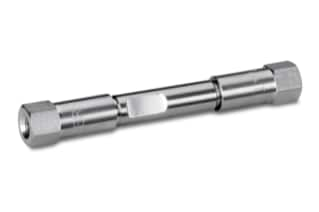
|
Chemistry |
C8 |
|
Separation Mode |
Reversed Phase |
|
Particle Substrate |
Silica |
|
pH Range Min |
2 pH |
|
pH Range Max |
8 pH |
|
Maximum Pressure |
6000 psi (415 Bar) |
|
Endcapped |
Yes |
|
Silanol Activity |
Low |
|
Particle Shape |
Spherical |
|
Particle Size |
5 µm |
|
Endfitting Type |
Waters |
|
Pore Size |
100 Å |
|
Format |
Column |
|
Surface Area |
340 |
|
System |
HPLC |
|
USP Classification |
L7 |
|
Inner Diameter |
4.6 mm |
|
Length |
50 mm |
|
Carbon Load |
12 % |
|
UNSPSC |
41115709 |
|
Brand |
SunFire |
|
Product Type |
Columns |
|
Units per Package |
1 pk |

SunFire C8 Column, 100Å, 5 µm, 4.6 mm X 50 mm, 1/pk
Due to its low pH stability, the SunFire C8 Column has a longer column lifetime than many other silica-based HPLC columns. High efficiency and increased sensitivity are provided by the SunFire C8 Column, which combines patented, cutting-edge silica synthesis, bonding, end-capping, and packing processes.
The SunFire C8 Column has a lower pH stability and a longer column lifetime than many other silica-based HPLC columns. The SunFire C8 Column uses unique, cutting-edge silica synthesis, end-capping, and packing techniques to deliver high efficiency and greater sensitivity.
There are numerous applications for mass spectrometry that use the SunFire C8 Column. The lab equipment has a number of characteristics, including sharp peaks, amazing sensitivity, high peak capacity, and extremely low bleed. Additionally, you can save time and money during analysis because of the SunFire C8 Column's excellent resolution, low back pressure, and speed.
Throughout the lifetime of the column, the lifetime of the method, and the lifetime of your new product, you can rely on the SunFire C8 Column to provide reliable chromatographic findings. This is due to the analytical column's original purpose, which was to build new analytical techniques for the most modern pharmaceutical and biopharmaceutical products. From year to year, batch to batch, and column to column, the SunFire C8 Column will exhibit the same excellent reproducibility.
To ensure that only top-notch lab equipment enters your lab, the SunFire C8 Column is manufactured using high-purity raw materials under tight quality control and packing procedures. Shop for lab equipment and pick the tools that are appropriate for you and your needs from a wide selection of Waters goods and offerings.
You should also review LCMS Certified Clear Glass 12 x 32 mm Screw Neck Vial, with Cap and Preslit PTFE/Silicone Septum, 2 mL Volume, 100/pk; Each and every Waters LCMS Certified vial is made using strictly regulated manufacturing and handling techniques. They are examined using mass spectrometers, and a certificate of analysis displaying the reference and vial scan for the production batch is supplied with them.
How Long Does It Take On Average To Change A Column?
In HPLC, column changes are a useful tool for method development and can be done on demand / as per the needs of the experiment. Fill the inlet fitting of your column with a gentle flow of solvent from the injector outlet line to prevent air from remaining in the column entrance. Before injecting a sample into a column to re-equilibrate it, we advise flushing the column with at least six columns of a fresh solvent. The second, third, and subsequent injections are typically reproducible; thus, the first injection should be disregarded.